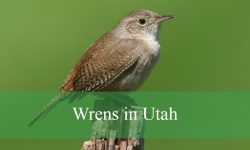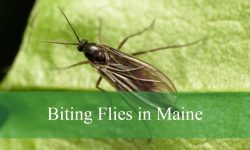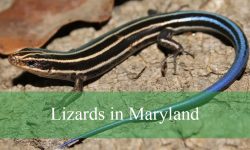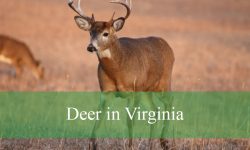A wide range of turtle species can be found in Florida, establishing the state as a prime location for observing these intriguing creatures. From freshwater ponds and rivers to coastal beaches and even the open ocean, the diverse habitats across the state support many unique species. Exploring the different turtles in Florida reveals the state’s rich biodiversity and natural beauty.
Turtles in Florida vary greatly in size, shape, and behavior, ranging from small mud turtles to the massive sea turtles that grace Florida’s shores. Each species has distinct characteristics that help with identification, including shell patterns, colors, and preferred environments. Learning these differences enhances the appreciation of the incredible variety of turtles found throughout the state.
This article explores 31 types of turtles in Florida, providing pictures and identification tips for each species. The comprehensive guide helps anyone interested in identifying turtles spotted in the wild or simply expanding their knowledge about Florida’s unique turtle population.
Different Types of Turtles Found in Florida
Yellow bellied Slider (Trachemys scripta scripta)

The Yellow-bellied Slider is a semi-aquatic turtle known for the distinctive bright yellow patches on the sides of its head and the yellow plastron (underside of the shell), often marked with dark spots. Adults typically reach 5 to 11 inches in length, with females growing significantly larger than males. Their carapace is olive to dark brown with yellow striping, giving them a vibrant appearance when basking in the sun.
This turtle is most active during the warmer months and is often seen basking on logs or rocks near water bodies. It prefers still or slow-moving freshwater environments such as ponds, lakes, swamps, and ditches. Though primarily aquatic, it regularly ventures onto land to bask and nest. It is a strong swimmer and usually retreats into the water when approached.
Yellow-bellied Sliders are omnivorous, feeding on aquatic vegetation, algae, insects, crustaceans, and small fish. Juveniles are more carnivorous, while adults tend to consume more plant material. In Florida, they are widespread and commonly found throughout the peninsula, especially in natural and man-made freshwater habitats with ample vegetation and basking sites.
Pond Slider (Trachemys scripta)
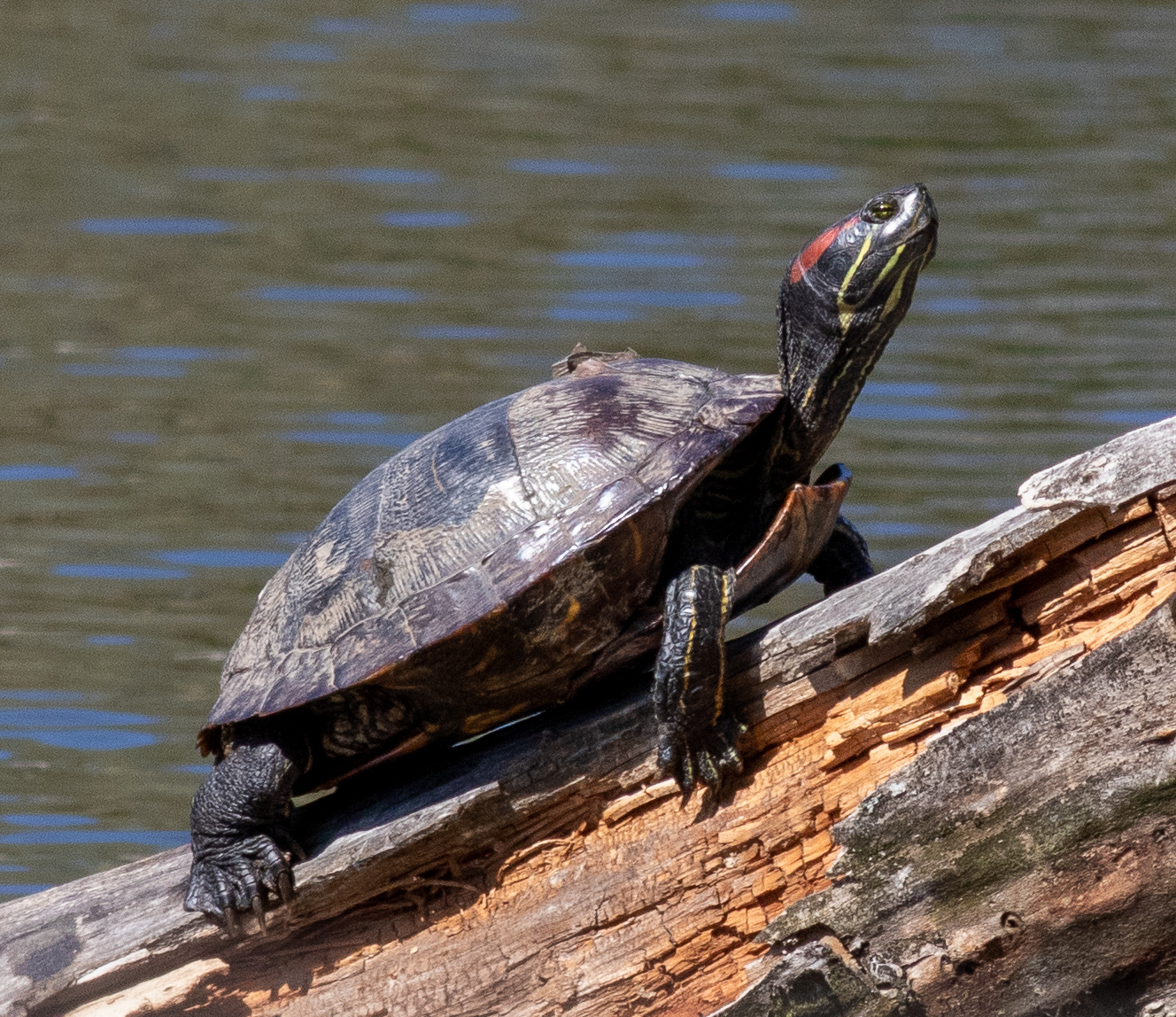
The Pond Slider is a highly adaptable freshwater turtle that includes several subspecies, one of the most recognized being the Red-eared Slider. It has an oval, slightly domed shell that ranges from olive to dark brown, often with lighter markings, and a plastron that may have dark spots. Adult sizes vary from 5 to 12 inches, with females being generally larger.
This species thrives in a variety of aquatic environments including ponds, lakes, streams, and marshes. It is frequently observed basking on logs, rocks, or banks in groups. Pond Sliders are known for their tolerance of human disturbance and can often be seen in urban water bodies. They are diurnal and most active during daylight hours, especially in warm weather.
Pond Sliders are opportunistic omnivores. Their diet includes aquatic plants, snails, insects, worms, and small fish. In Florida, this species is well-established in the wild and is often found in the same habitats as native turtles, particularly in areas with plentiful aquatic vegetation and basking sites. It is considered invasive in some parts due to competition with native species.
Common Snapping Turtle (Chelydra serpentina)

The Common Snapping Turtle is one of the largest freshwater turtles in North America, with a rugged, muscular build and a powerful hooked jaw. It has a rough, dark brown to black carapace that can reach up to 18 inches, though most individuals are smaller. Its long tail, often as long as the shell itself, features dinosaur-like ridges.
This species prefers slow-moving or still bodies of water with soft, muddy bottoms and dense aquatic vegetation. It spends most of its time submerged, with only its eyes and nostrils exposed above water. Snapping turtles are primarily nocturnal and are rarely seen basking. On land, they may appear aggressive, especially during the nesting season or when encountered on roads.
Common Snapping Turtles are omnivorous and highly opportunistic feeders. Their diet includes aquatic plants, fish, frogs, invertebrates, carrion, and even small mammals or birds when available. In Florida, they are found in rivers, lakes, marshes, and even drainage ditches. Though widespread, they are more secretive than other turtles and are often only noticed when crossing roads in summer.
Common Musk Turtle (Sternotherus odoratus)

The Common Musk Turtle, also known as the “Stinkpot,” is a small, aquatic species named for the musky odor it emits when threatened. Adults typically measure between 3 and 5 inches in length. It has a domed, dark-colored shell that may appear black, gray, or brown, and a pointed head with two distinctive yellow stripes running from the nose to the neck.
This turtle is mostly aquatic and spends its life in slow-moving waters like swamps, ponds, and backwaters of rivers. Unlike many other turtles, it seldom basks out of water, instead clinging to submerged branches or walking along the bottom. It is a skilled climber and is occasionally seen climbing low vegetation above the water.
Common Musk Turtles are omnivores with a diet consisting mainly of insects, snails, small crustaceans, and plant material. They forage primarily at night and use their keen sense of smell to locate food. In Florida, they are commonly found in freshwater wetlands, including cypress swamps and quiet streams, especially in the central and northern parts of the state.
Florida Softshell Turtle (Apalone ferox)
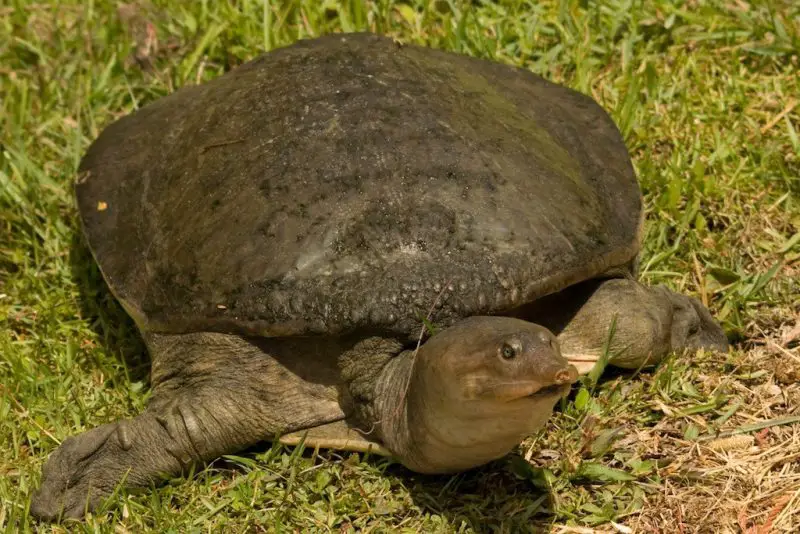
The Florida Softshell Turtle is a large, flattened turtle with a leathery, smooth carapace that lacks the hard scutes typical of most turtles. Its shell is olive to dark brown and can grow up to 24 inches long, making it one of the largest freshwater turtles in Florida. It has a long neck, a snorkel-like nose, and powerful webbed feet that aid in swimming.
This turtle prefers lakes, rivers, canals, and marshes with sandy or muddy bottoms where it can bury itself for camouflage. It is highly aquatic and rarely leaves the water except for nesting. Despite its large size, it is fast and agile both in water and on land. Florida Softshells are known for their aggressive defense behavior when threatened.
They are carnivorous and feed on fish, frogs, insects, crustaceans, and carrion. They often ambush prey by lying buried in the sediment with only their head exposed. In Florida, this species is widespread across the peninsula and panhandle, thriving in both natural and human-altered freshwater environments.
Eastern Mud Turtle (Kinosternon subrubrum)
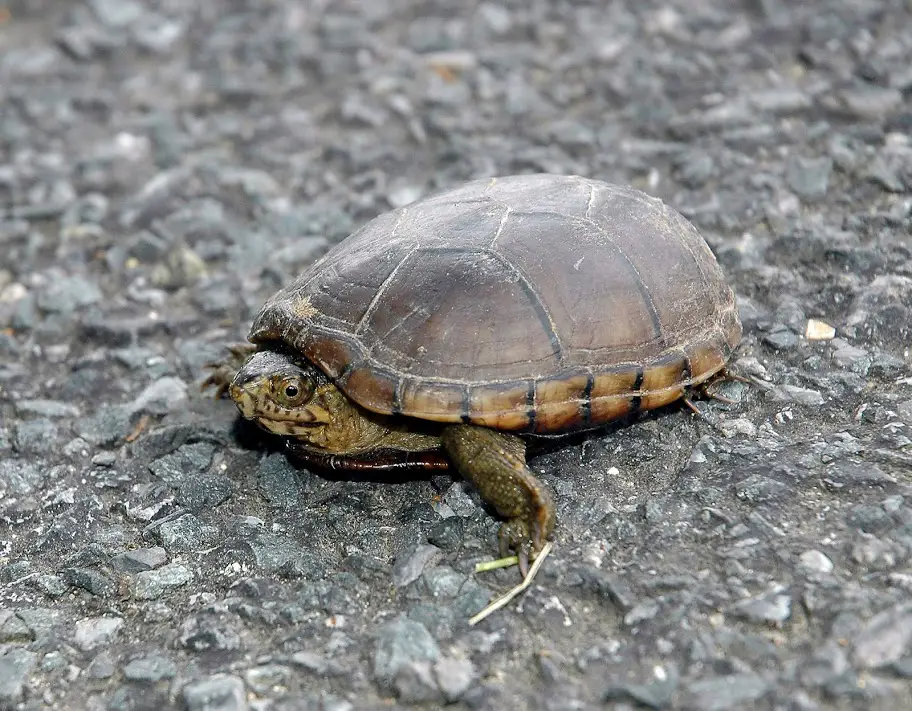
The Eastern Mud Turtle is a small, oval-shaped turtle with a smooth, domed shell that typically measures 3 to 4 inches in length. Its carapace is brown to olive, often uniform in color, and lacks any striking patterns. The plastron is relatively large and hinged, allowing the turtle to close its shell tightly when threatened. Its skin is dark with occasional lighter markings on the head or throat.
This species inhabits a wide range of shallow freshwater environments, including marshes, ditches, swamps, and ponds. It is known for being secretive and spends much of its time buried in mud or leaf litter. Unlike many turtles, the Eastern Mud Turtle is more active during dusk and dawn, and it can tolerate brief periods of terrestrial activity, especially during wet seasons or while nesting.
Eastern Mud Turtles are omnivores, feeding on insects, worms, mollusks, crustaceans, and some plant matter. They use their strong sense of smell to locate food while walking along the bottom of the water. In Florida, they are found throughout the northern and central parts of the state, especially in slow-moving or still waters with muddy or vegetated substrates.
Florida Red Bellied Cooter (Pseudemys nelsoni)

The Florida Red-bellied Cooter is a brightly colored freshwater turtle known for its reddish-orange plastron, which gives the species its name. Its carapace is oval and dark with swirling yellowish patterns, and adults can grow to 8 to 15 inches long. The species is often confused with other cooters, but its red belly and two light stripes on the head help distinguish it.
This turtle inhabits rivers, lakes, ponds, and marshes with abundant aquatic vegetation. It prefers clear, slow-moving or still waters and is commonly seen basking on logs or rocks. The Florida Red-bellied Cooter is diurnal and most active during daylight hours. It is also one of the few turtles known to occasionally nest in alligator nests, possibly for added protection from predators.
Primarily herbivorous, the Florida Red-bellied Cooter feeds on aquatic plants, algae, and occasionally small invertebrates. Juveniles may consume more protein, but adults are mostly plant eaters. This species is found almost exclusively in the Florida peninsula, ranging from the panhandle down through the central and southern regions.
Coastal Plain Cooter (Pseudemys floridana)
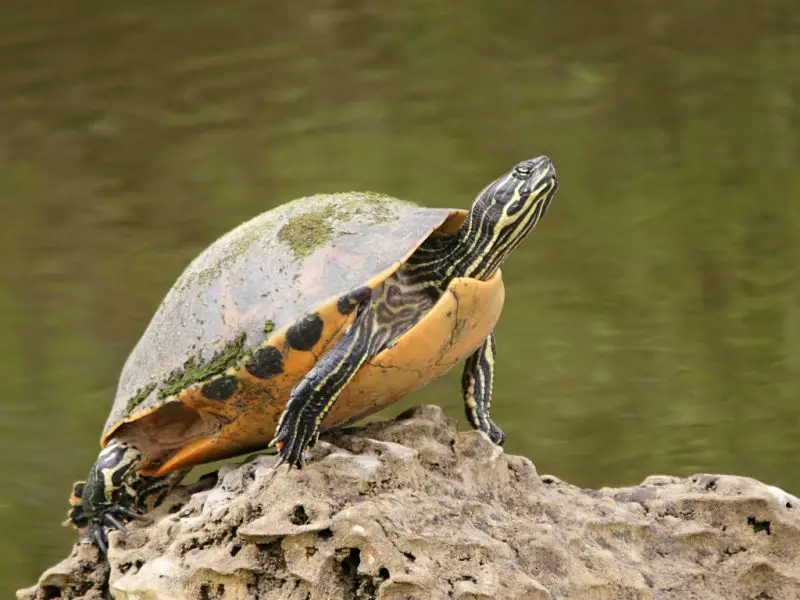
The Coastal Plain Cooter is a large freshwater turtle with a dark olive to black carapace marked by light vertical lines or swirls. The plastron is yellow and usually unmarked. Adults can reach up to 13 inches in length. It has a relatively flat shell and a long, striped head with yellow lines extending down the neck and limbs.
This species prefers larger, open bodies of water such as rivers, lakes, and swamps. It is an avid basker and is often seen stacked with others on logs or banks. The Coastal Plain Cooter is a strong swimmer and rarely ventures far from water, except during the nesting season. It is most active during the warmer months and often seen in groups.
The diet is mainly herbivorous, consisting of aquatic vegetation, algae, and occasionally invertebrates. Its feeding habits help control excessive plant growth in its habitat. In Florida, the Coastal Plain Cooter is found primarily in the northern and western regions, including the Panhandle, where it shares habitats with other cooters and basking turtle species.
Peninsula Cooter (Pseudemys peninsularis)

The Peninsula Cooter is a visually striking turtle with an oval, dark carapace patterned with intricate yellow-orange lines. Its plastron is yellow and usually free of markings, while the head features prominent yellow stripes. Adults can grow up to 15 inches, making it one of the larger freshwater turtles in Florida.
This species is native to the Florida peninsula and is commonly found in slow-moving rivers, lakes, springs, and marshes with abundant aquatic plants. It is a frequent basker and is often seen on rocks, logs, or floating vegetation. Peninsula Cooters are highly aquatic and prefer clear, warm waters with ample sunlight and submerged vegetation for feeding and shelter.
Peninsula Cooters are primarily herbivores, feeding on a variety of aquatic plants and algae. Juveniles may eat more animal matter, but plant-based diets dominate in adulthood. This turtle is widely distributed across the central and southern Florida peninsula, thriving in both natural and suburban freshwater environments with low current and plenty of vegetation.
River Cooter (Pseudemys concinna)
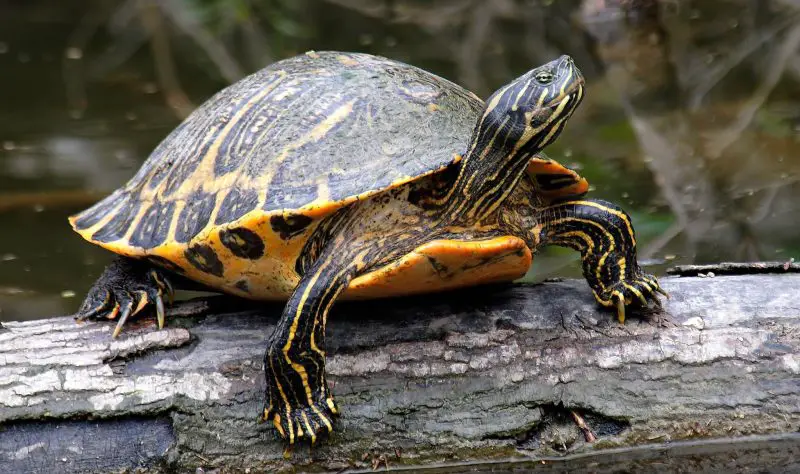
The River Cooter is a large freshwater turtle with a dark, slightly domed carapace that displays vivid yellow to orange markings, often in concentric or irregular swirls. Its plastron is yellow with varying dark patches, and it has a striped head and limbs. Adults can reach up to 12 to 16 inches, with females growing larger than males.
It favors larger rivers, spring-fed streams, and lakes with moderate to strong currents and clear water. This species is highly aquatic but frequently climbs onto logs or rocks to bask. It is a fast swimmer and uses its strong limbs to navigate flowing water. River Cooters are often seen coexisting with other basking turtles in suitable habitats.
The River Cooter is mainly herbivorous, feeding on aquatic plants, algae, and occasionally invertebrates like snails and insects. In Florida, it is found primarily in the northern part of the state, particularly in rivers and clear streams with sandy or rocky bottoms and good vegetation. Its range overlaps with several other cooter species, but its preferred riverine habitat sets it apart.
Loggerhead Musk Turtle (Sternotherus minor)
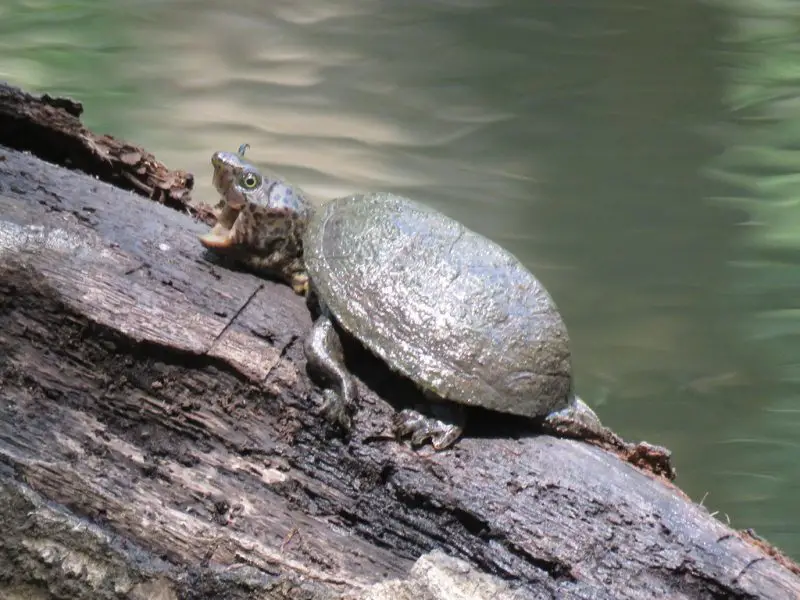
The Loggerhead Musk Turtle is a small to medium-sized species known for its large, broad head with strong jaws and blunt snout. Its carapace is typically olive to brown with dark spots or streaks, and it has a relatively domed and narrow shell that can reach about 3 to 5 inches in length. The skin is usually grayish with lighter markings on the head and neck.
This turtle prefers clear, spring-fed rivers and streams with rocky or sandy bottoms. It is an aquatic species that often hides under submerged logs, rocks, or leaf debris and is not commonly seen basking. Unlike many other turtles, the Loggerhead Musk Turtle is slow-moving and spends most of its time underwater, using its strong head and jaws to forage.
Carnivorous by nature, it feeds on snails, crustaceans, aquatic insects, and small fish. Its powerful jaws are well-adapted for crushing hard-shelled prey. In Florida, the Loggerhead Musk Turtle is found mainly in the northern and central parts of the state, especially in the Suwannee River drainage and other spring systems where clean, oxygen-rich waters support its food sources.
Striped Mud Turtle (Kinosternon baurii)
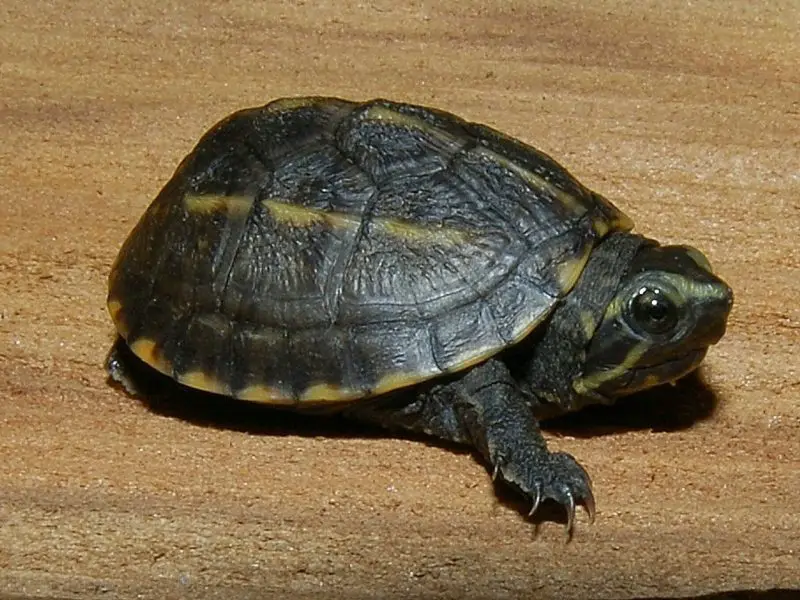
The Striped Mud Turtle is a small, distinctive turtle identified by the three light stripes running the length of its dark brown or black carapace. Its shell is smooth and slightly domed, reaching 3 to 4 inches in length. The head is striped with yellow lines, and the plastron is pale with dark seams and a hinged front lobe.
Highly adaptable, this turtle inhabits a wide range of freshwater environments including marshes, canals, swamps, and ditches. It is frequently seen crossing land, especially during rainy seasons, and is more terrestrial than many other mud turtles. The Striped Mud Turtle is most active during warm months and often burrows into mud or under vegetation during dry periods.
Its diet includes insects, worms, snails, and some plant material. It forages in shallow water and muddy areas using its sense of smell and probing snout. In Florida, the Striped Mud Turtle is found throughout the peninsula and southern regions, especially in habitats with a mix of aquatic and terrestrial cover and soft substrates.
Florida Mud Turtle (Kinosternon steindachneri)

The Florida Mud Turtle is a small, dark-colored turtle endemic to Florida. It has a smooth, dome-shaped brown or grayish carapace and a hinged plastron that allows it to close up tightly for protection. Adults generally measure around 3 to 4 inches in length. Its head and limbs are usually dark, and the eyes may have a light ring around them.
This species prefers calm, shallow bodies of water such as marshes, wet prairies, ditches, and ponds, often with sandy or muddy bottoms. It is also known for being fairly terrestrial and can be seen traveling across land, particularly during wet seasons or after heavy rains. The Florida Mud Turtle is elusive and tends to stay hidden in vegetation or soft substrates.
It feeds on a wide variety of animal matter including insects, worms, snails, and small crustaceans. Occasionally, it may consume aquatic plants or algae. As its name suggests, the Florida Mud Turtle is found only in Florida, especially in the central and southern parts of the peninsula where sandy soils and low-lying wetlands are common.
Painted Turtle (Chrysemys picta)

The Painted Turtle is a colorful and easily recognizable freshwater turtle with a smooth, flat carapace that is olive to black and edged in red or orange. Its plastron is bright yellow or orange with a distinctive dark blotch in the center. The head, neck, and limbs are marked with bold yellow and red stripes. Adults range from 4 to 10 inches in length.
This species prefers ponds, lakes, slow-moving streams, and marshes with soft bottoms and ample basking spots. It is diurnal and often seen basking in groups on logs or rocks. Painted Turtles are strong swimmers and typically hibernate in the mud at the bottom of their water bodies during colder months.
They are omnivores, feeding on aquatic vegetation, algae, insects, snails, and small fish. Juveniles tend to consume more animal matter, while adults include more plant material in their diet. In Florida, Painted Turtles are not as widespread as in northern states but can be found in the northern regions of the state, particularly in suitable quiet water habitats.
Diamondback Terrapin (Malaclemys terrapin)
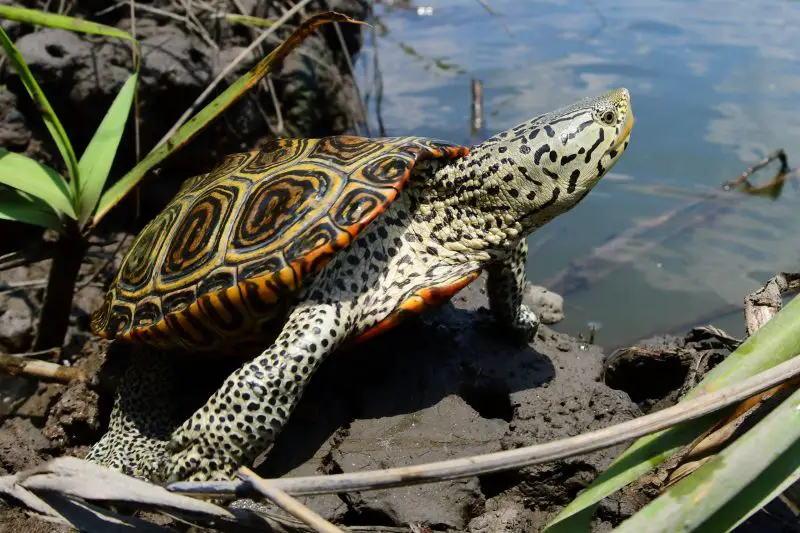
The Diamondback Terrapin is a unique brackish-water turtle with a light gray to whitish skin covered in black spots and a high-domed, patterned carapace that ranges from gray to brown with concentric markings. Its shell can measure 5 to 9 inches long, and its distinctively spotted or streaked face makes it easy to recognize.
Unlike most freshwater turtles, the Diamondback Terrapin lives in salt marshes, tidal creeks, estuaries, and mangroves. It is well-adapted to brackish environments and can tolerate fluctuations in salinity. These turtles are diurnal and spend a lot of time swimming and foraging in shallow coastal waters, often coming ashore to bask or nest on sandy banks.
They are carnivorous and primarily feed on crustaceans, mollusks, worms, and small fish, using their strong jaws to crush shells. In Florida, Diamondback Terrapins are found along the Atlantic and Gulf coasts, especially in salt marshes from the Panhandle to the Keys, though they are considered uncommon and are of conservation concern due to habitat loss and nest predation.
Spotted Turtle (Clemmys guttata)
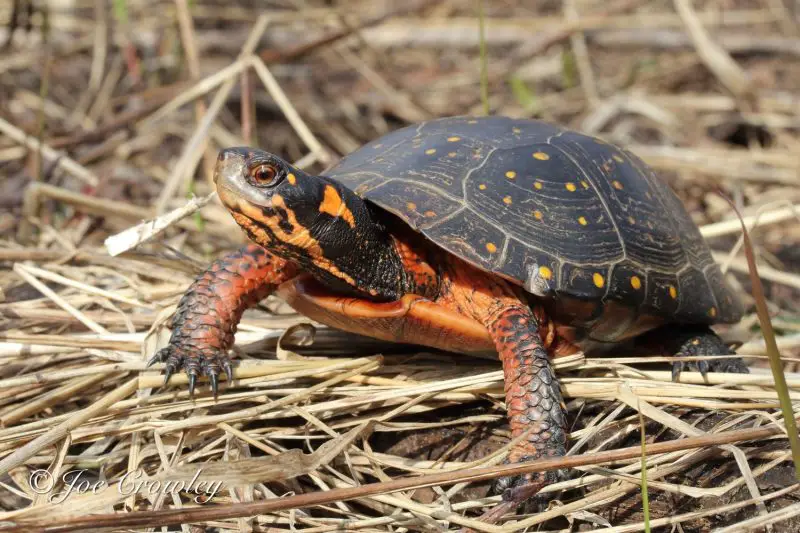
The Spotted Turtle is a small, semi-aquatic species recognized by its smooth, black shell adorned with distinctive bright yellow spots. These spots also appear on the head, neck, and limbs, though their number and arrangement vary among individuals. Adults generally measure between 3.5 to 5 inches in shell length, making them one of the smallest turtles in Florida.
This turtle favors shallow, clean, and vegetated wetlands such as marshes, bogs, swamps, and vernal pools. It is primarily active in the spring and becomes dormant during the hottest parts of summer and coldest parts of winter. Spotted Turtles are known for their secretive behavior and are often buried under leaf litter or hiding among submerged plants.
Their diet consists of small invertebrates like worms, snails, insects, and occasionally plant material. Spotted Turtles are most commonly found in northern Florida, especially in the Panhandle, where isolated and pristine wetland habitats remain. Due to habitat loss and collection pressures, they are considered a species of conservation concern.
Gopher Tortoise (Gopherus polyphemus)
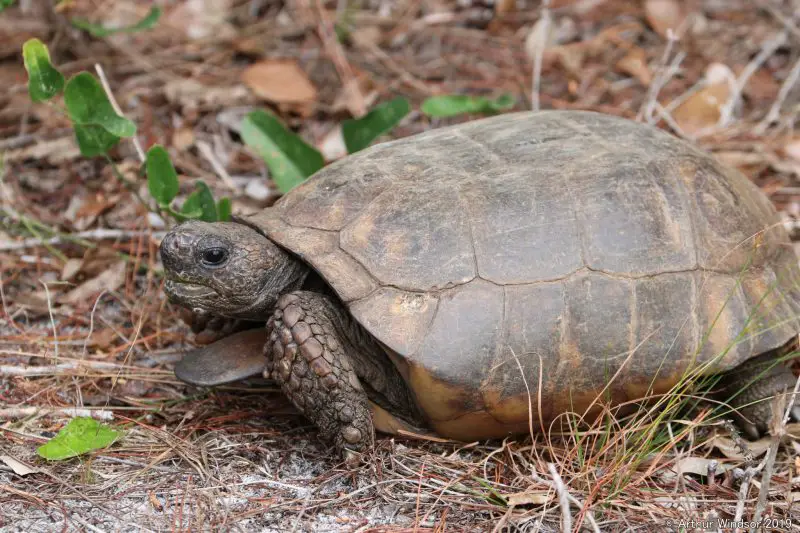
The Gopher Tortoise is a land-dwelling tortoise with a domed, brown to gray shell and strong, shovel-like front legs adapted for digging. Adults typically reach 9 to 15 inches in length. The plastron is yellowish and flat, and the skin is thick and scaly, helping it thrive in dry, sandy environments.
This species is famous for its burrowing behavior, creating long and deep burrows that provide shelter not only for itself but for over 350 other species, making it a keystone species in its ecosystem. Gopher Tortoises are diurnal, herbivorous, and feed on a variety of grasses, weeds, wildflowers, and fruits. They are solitary and can live for several decades in stable environments.
Gopher Tortoises are found throughout the sandy uplands of Florida, including pine flatwoods, scrub, coastal dunes, and dry prairies. They are most common in central and northern Florida but can be found statewide. Due to habitat destruction and human interference, they are protected under state law and are a candidate for federal protection.
Loggerhead Sea Turtle (Caretta caretta)
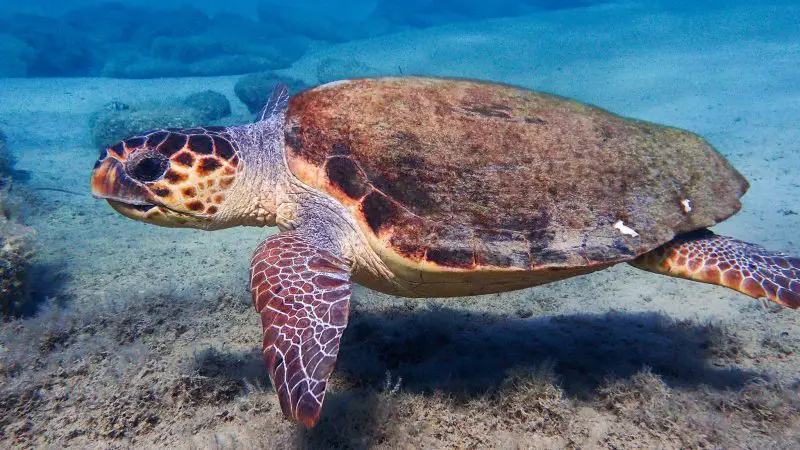
The Loggerhead Sea Turtle is a large marine turtle named for its massive, broad head and powerful jaws. It has a reddish-brown carapace that can grow up to 3 feet in length and weigh over 250 pounds. The flippers are thick and paddle-like, adapted for long-distance ocean travel.
This sea turtle spends most of its life in the open ocean and coastal areas, often frequenting bays, estuaries, and continental shelves. Females come ashore primarily at night to nest on sandy beaches, where they lay their eggs in deep pits. Nesting typically occurs from late spring through summer. Loggerheads are known for their long migrations between feeding and nesting areas.
Their diet consists mostly of hard-shelled prey such as crabs, mollusks, and sea urchins, using their strong jaws to crush them. Florida hosts one of the largest nesting populations of Loggerhead Sea Turtles in the world, especially along the Atlantic coast from Brevard to Palm Beach County, as well as in the Gulf Coast regions.
Chicken Turtle (Deirochelys reticularia)
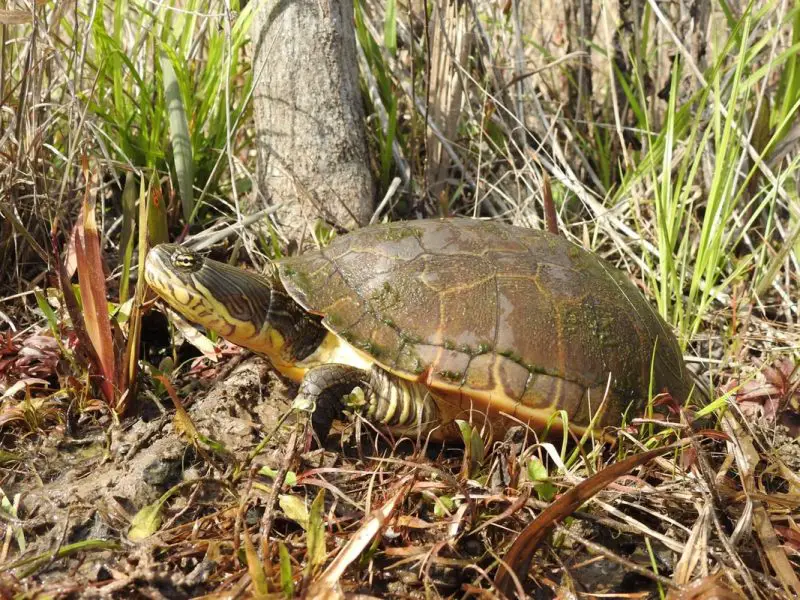
The Chicken Turtle is a medium-sized freshwater turtle with a long neck and an oval-shaped, dark brown to olive shell patterned with a net-like yellow reticulation. Adults grow to about 6 to 10 inches in length. The legs and neck have yellow stripes, and the plastron is yellow or cream-colored.
This species prefers still or slow-moving freshwater habitats such as ponds, marshes, ditches, and cypress swamps, often with dense vegetation. Chicken Turtles are known for being semi-terrestrial, often traveling over land in search of new habitats or during nesting. They are active mostly during cooler months and may aestivate during hot summer periods.
Omnivorous in diet, they eat aquatic invertebrates, small fish, amphibians, and plant matter. Chicken Turtles are widely distributed across Florida, especially in the northern and central regions, but they are more frequently encountered in the Panhandle and north-central areas with suitable wetland systems.
Suwannee Cooter (Pseudemys concinna suwanniensis)
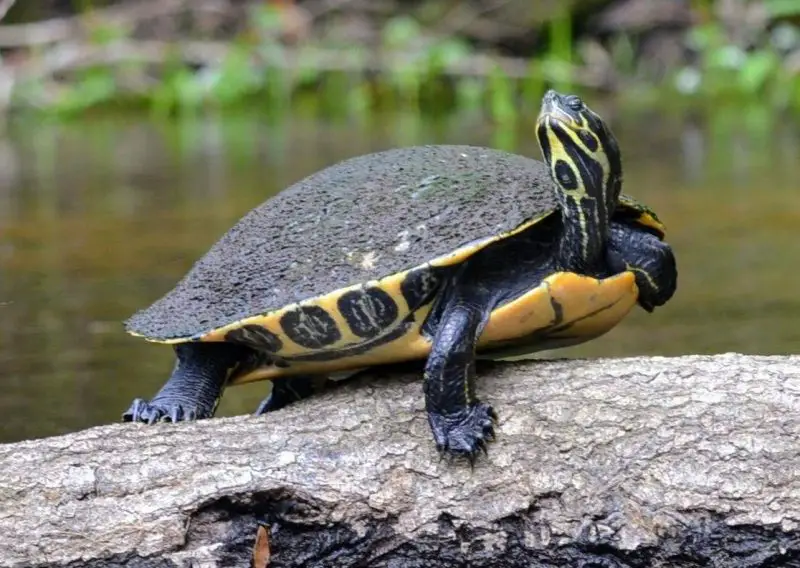
The Suwannee Cooter is a large freshwater turtle and a subspecies of the River Cooter, distinguished by its dark, often blackish carapace with intricate yellow to orange markings and swirls. The shell can reach up to 13 inches in length, and the plastron is yellow with dark pigment along the seams. The head and limbs have thin, pale stripes.
This turtle is primarily aquatic and inhabits rivers, springs, and large streams with strong currents and clear water. It is often seen basking on logs or rocks during the day and is a strong swimmer. The Suwannee Cooter is known for being shy and quick to dive when approached, spending much of its time submerged.
It feeds mainly on aquatic plants, algae, and occasionally invertebrates. The Suwannee Cooter is found only in the Suwannee River system in northern Florida and southern Georgia. Due to its limited range and declining populations, this turtle is considered a species of concern and is protected from harvest in Florida.
Barbour’s Map Turtle (Graptemys barbouri)
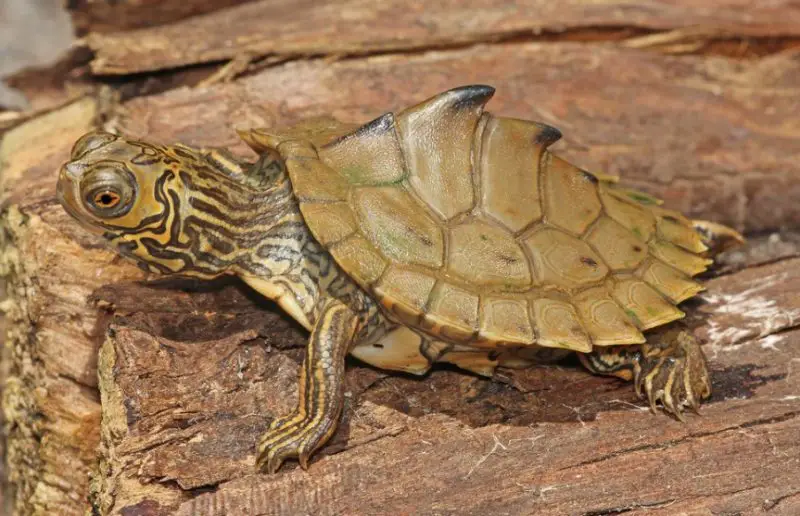
Barbour’s Map Turtle is a visually striking species with a dark, keeled shell marked by faint yellowish lines and large spines or knobs along the center ridge, especially prominent in males. Females are much larger than males, sometimes reaching up to 12 inches in shell length, while males rarely exceed 5 inches. Both sexes display yellow stripes on the head and neck and a dark blotch behind each eye.
This species prefers clear, fast-moving freshwater rivers with sandy or rocky bottoms and abundant basking sites like logs and rocks. It is highly aquatic and spends much of its time submerged or basking. Barbour’s Map Turtle is shy and quick to retreat into the water when disturbed, often diving and swimming with agility.
Their diet varies by sex, with females primarily consuming hard-shelled prey like snails and mussels thanks to their strong jaws, while males feed more on insects and other invertebrates. In Florida, Barbour’s Map Turtle is found only in rivers of the Panhandle, particularly the Apalachicola and Chipola Rivers, making it a localized but notable species.
Escambia Map Turtle (Graptemys ernsti)
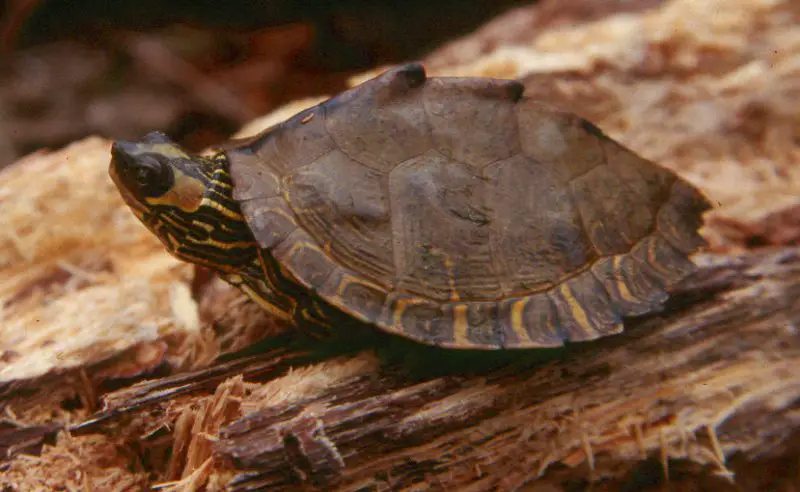
The Escambia Map Turtle is a rare and localized species with a dark olive shell featuring fine yellow lines resembling a topographic map. Like other map turtles, it has a prominent keel along the back, and males are significantly smaller than females. The species can be identified by the crescent-shaped mark behind the eye and subtle shell patterning.
It inhabits large, swift-flowing rivers with abundant basking sites and clean, sandy or rocky substrates. Escambia Map Turtles are secretive and remain close to the water, basking frequently on fallen logs. Their activity peaks during warmer months, and they often hide under submerged logs or along the riverbed when threatened.
These turtles feed primarily on aquatic invertebrates, including snails and insects, with females eating larger and harder prey. In Florida, they are found exclusively in the Escambia River drainage in the far western Panhandle. Their restricted range and dependence on pristine river habitats make them vulnerable to environmental disturbances.
False Map Turtle (Graptemys pseudogeographica)
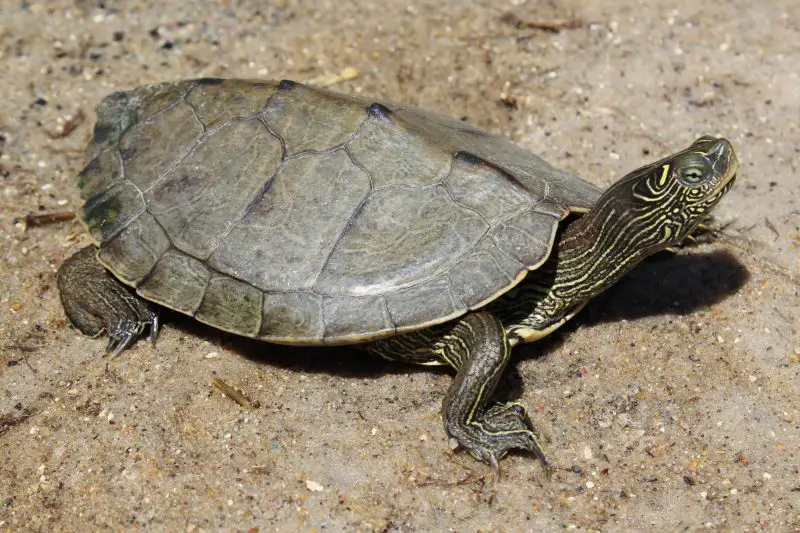
The False Map Turtle is a medium-sized turtle with an olive to dark brown shell adorned with light lines that form a map-like pattern. A low keel runs along the center of the carapace, and a distinct backward L- or S-shaped mark is present behind each eye. Adult females can reach 10 inches in length, while males typically remain under 6 inches.
This turtle prefers large rivers and slow-moving waters with abundant basking sites and aquatic vegetation. It is highly aquatic, basking frequently during the day and diving when disturbed. False Map Turtles are good swimmers and spend much of their time foraging underwater or resting along submerged structures.
Their diet includes aquatic insects, mollusks, crustaceans, and some plant matter. In Florida, they are not native but may occasionally be found in the extreme northwestern part of the Panhandle, likely introduced or drifting from neighboring states. Their presence is rare and considered peripheral in the state.
Alligator Snapping Turtle (Macrochelys temminckii)

The Alligator Snapping Turtle is one of the largest freshwater turtles in the world, with a rugged, dinosaur-like appearance. It has a massive head, powerful beak-like jaws, and a ridged carapace with three prominent keels. Adults can weigh over 150 pounds and have a dark brown to blackish shell with a long, spiked tail.
This species lives in deep rivers, lakes, and swamps with slow-moving water and abundant submerged structures. It is mostly sedentary and spends most of its time on the river bottom, using its worm-like tongue to lure fish into its open mouth. Alligator Snapping Turtles are nocturnal and extremely reclusive.
They feed on fish, amphibians, carrion, and even other turtles, using ambush tactics rather than active hunting. In Florida, they are primarily found in the Panhandle in river systems connected to the Apalachicola, Escambia, and Choctawhatchee Rivers. They are a protected species due to historical overharvesting and habitat degradation.
Spiny Softshell Turtle (Apalone spinifera)
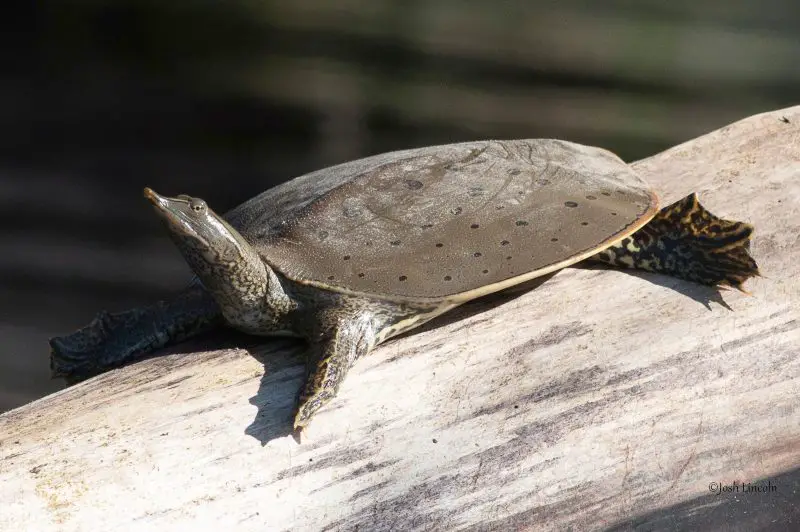
The Spiny Softshell Turtle is easily recognized by its flat, pancake-like body and leathery, flexible shell covered with small spines or bumps along the front edge. The coloration is olive to tan with dark spots or blotches. Males are smaller and more patterned than the larger, less colorful females, which can reach up to 18 inches in shell length.
It is a highly aquatic species that prefers rivers, lakes, and streams with sandy or muddy bottoms. Spiny Softshells are fast swimmers and agile in the water, often burying themselves in the substrate with just their eyes and snout exposed. They are primarily diurnal and spend much time basking on riverbanks or logs.
Their diet includes fish, insects, crayfish, and other aquatic invertebrates, as well as some plant matter. In Florida, they are found mainly in the northern and western parts of the state, including the Panhandle. They are less commonly seen than the Florida Softshell Turtle but are present in suitable habitats with clean water and open sandy areas.
Smooth Softshell Turtle (Apalone mutica)
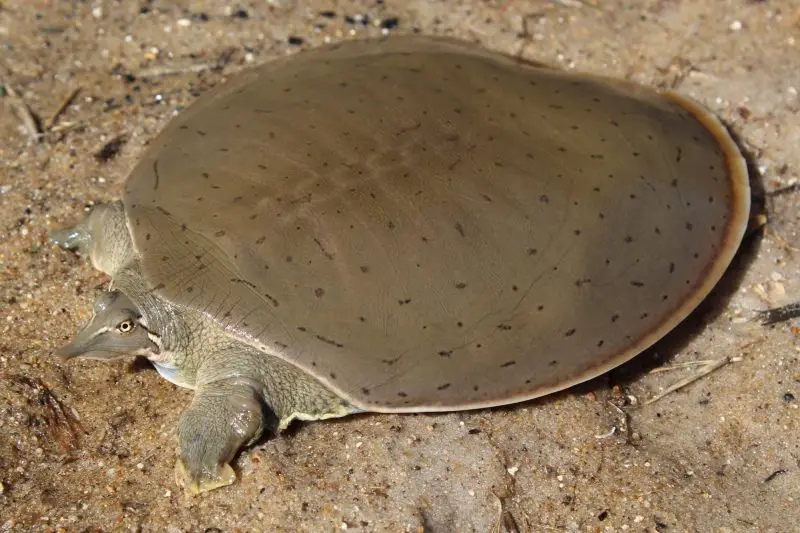
The Smooth Softshell Turtle has a distinctively flat, pancake-like body with a smooth, leathery shell that lacks the spines seen in other softshell turtles. Its coloration typically ranges from olive to tan, often with subtle dark spots or blotches across the carapace. Males are generally smaller and more brightly patterned than females, which can grow up to about 15 inches in shell length.
This species prefers clear, slow-moving rivers, streams, and ponds with sandy or muddy bottoms where it can easily bury itself for camouflage and protection. It is an agile swimmer, spending much of its time underwater and quickly escaping threats by swimming away or hiding under the substrate. Smooth Softshell Turtles are often seen basking on sandy banks or logs.
Their diet consists mainly of aquatic insects, small fish, and crustaceans. In Florida, the Smooth Softshell Turtle is found primarily in the northern and panhandle regions, inhabiting clean freshwater systems with abundant sand or mud bottoms suitable for burrowing and foraging.
Green Sea Turtle (Chelonia mydas)
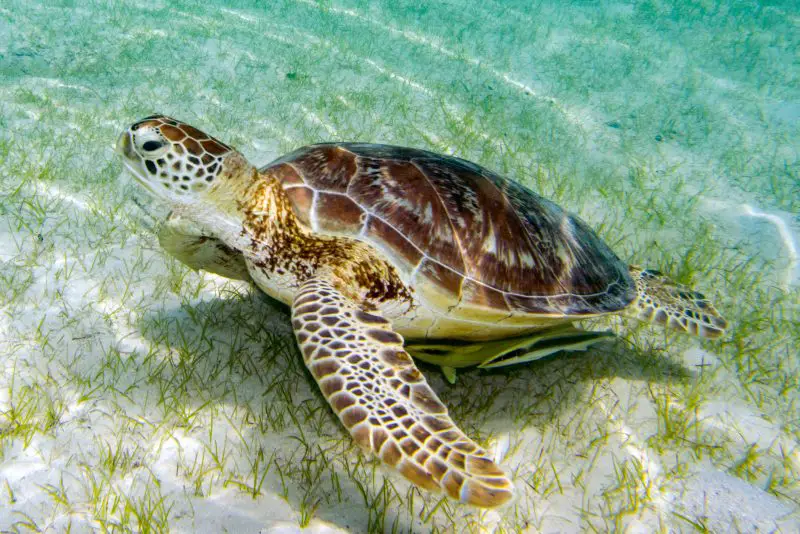
The Green Sea Turtle is a large, herbivorous marine turtle named for the greenish color of its body fat rather than its shell, which is usually a smooth olive or brown with radiating patterns. Adult turtles can reach up to 4 feet in shell length and weigh up to 700 pounds. They have a streamlined shell and paddle-like flippers adapted for long-distance swimming in the ocean.
Green Sea Turtles primarily inhabit coastal waters, coral reefs, and seagrass beds where they graze on marine vegetation. They are known for their migratory behavior, often traveling great distances between feeding grounds and nesting beaches. These turtles are generally slow swimmers but capable of sustained movement over long distances.
In Florida, Green Sea Turtles nest mainly along the Atlantic coast and the Florida Keys during warmer months. They feed primarily on seagrasses and algae, playing an important role in maintaining healthy seagrass ecosystems. Their population is protected due to past declines caused by habitat loss and human activities.
Leatherback Sea Turtle (Dermochelys coriacea)
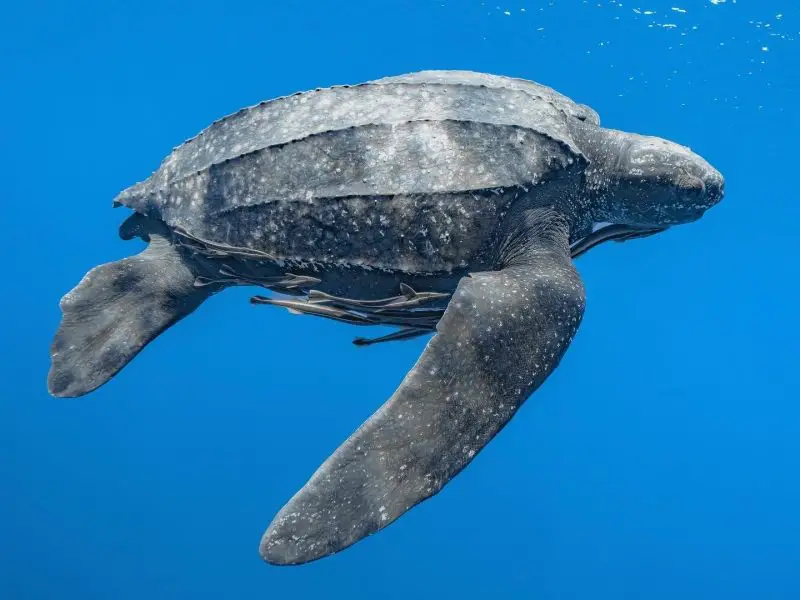
The Leatherback Sea Turtle is the largest of all sea turtles and has a unique leathery shell without hard scutes, distinguished by seven longitudinal ridges running down its back. Adults can exceed 6 feet in length and weigh over 1,500 pounds, making them an impressive sight in the ocean. Their dark shell is often mottled with white spots.
Leatherbacks are highly migratory and capable of diving to great depths in the open ocean. They primarily feed on jellyfish and other soft-bodied prey, using sharp, backward-pointing spines in their throats to prevent their slippery food from escaping. Unlike other sea turtles, they tolerate colder waters and are found in both tropical and temperate seas.
In Florida, Leatherback Sea Turtles occasionally nest along the Atlantic coast but are more commonly seen offshore. Due to their extensive range and deep-water habits, they are less frequently encountered near shore but remain an important species for marine conservation efforts because of their threatened status.
Kemp’s Ridley Sea Turtle (Lepidochelys kempii)
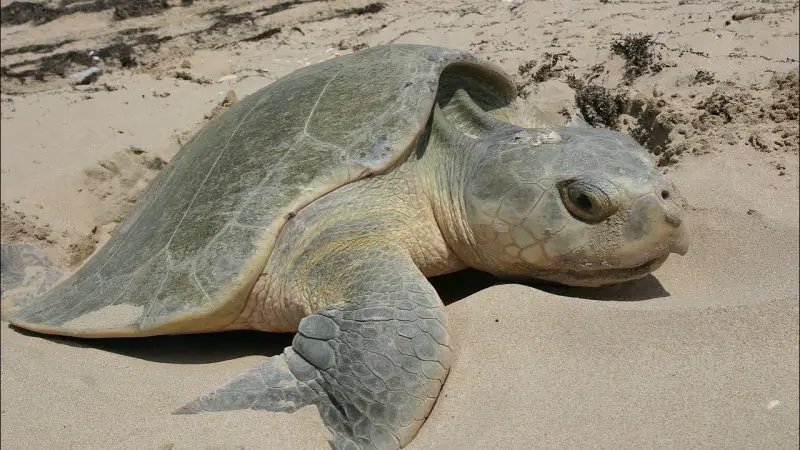
Kemp’s Ridley Sea Turtle is the smallest of the sea turtles, typically measuring around 2 feet in shell length and weighing up to 100 pounds. Its shell is heart-shaped and olive-gray to greenish in color. This species is highly distinctive due to its unique nesting behavior, which involves mass synchronized nesting events called arribadas.
This turtle favors shallow coastal waters where it feeds primarily on crabs and other crustaceans. Kemp’s Ridleys are strong swimmers and often forage close to shore. They are also known for their short-distance migrations between nesting beaches and feeding areas. Their nesting sites are mostly concentrated along the Gulf Coast.
In Florida, Kemp’s Ridley Sea Turtles are observed mainly in the Gulf of Mexico region. Conservation efforts have helped increase their numbers after severe declines caused by egg harvesting and fishing bycatch. They are one of the most endangered sea turtles but remain a focus of recovery programs.
Hawksbill Sea Turtle (Eretmochelys imbricata)

The Hawksbill Sea Turtle is easily recognized by its pointed beak-like mouth and overlapping, serrated scutes on its shell, giving it a jagged appearance. Its shell features beautiful patterns of amber, brown, and yellow, often with a mottled or streaked look. Adults reach about 2.5 to 3 feet in shell length and weigh around 100 to 150 pounds.
Hawksbills inhabit coral reefs and rocky coastlines, where they feed mainly on sponges, which constitute the majority of their diet, along with other invertebrates. Their strong jaws allow them to extract food from crevices. These turtles are often found basking on coral ledges or resting underwater within reef structures.
In Florida, Hawksbill Sea Turtles are most commonly seen in the Florida Keys and along the southeastern coast, particularly near coral reefs. They are critically endangered due to habitat loss, poaching for their beautiful shells, and bycatch in fishing gear, leading to significant conservation attention.
Olive Ridley Sea Turtle (Lepidochelys olivacea)

The Olive Ridley Sea Turtle is a medium-sized sea turtle with a smooth, olive-green to grayish shell that is relatively round and slightly flattened. Adults typically measure around 2 feet in shell length and weigh up to 100 pounds. Their name comes from the olive coloration of their carapace.
This species is known for its unique mass nesting behavior called arribadas, where thousands of females come ashore simultaneously to lay eggs on select beaches. Olive Ridleys prefer warm, tropical waters and feed mainly on jellyfish, shrimp, crabs, and algae. They are strong swimmers and often inhabit coastal and offshore waters.
In Florida, Olive Ridley Sea Turtles are rare visitors, usually seen in offshore waters rather than nesting on beaches. Sightings are uncommon but important for understanding the range and migration of this species. They are considered vulnerable due to threats such as habitat destruction and bycatch.


